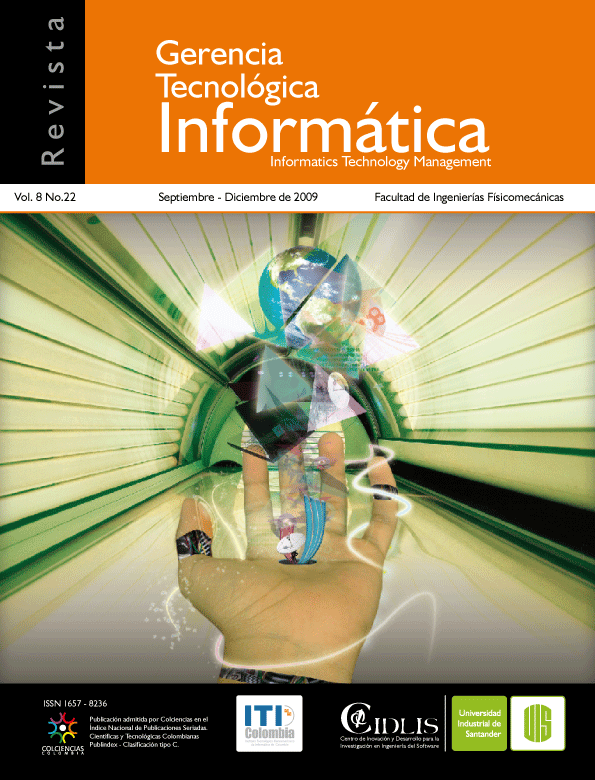IMPLEMENTACIÓN DE UN PROTOTIPO DE PRUEBA PARA DESARROLLOS EN VISIÓN ARTIFICIAL
How to Cite
Abstract
RESUMEN
En este artículo se muestra como puede ser implementado un sistema estereoscópico simple usando dos cámaras de televisión, el cual puede ser usado para realizar pruebas en el desarrollo de diferentes proyectos en visión artificial. El sistema implementado usa cámaras fijas y segmentación por color para establecer la correspondencia entre las imágenes, mediante un algoritmo desarrollado en Matlab. La función básica del prototipo es estimar la distancia a la que se encuentran los objetos en un entorno. Con el fin de obtener un buen grado de precisión en la estimación de la distancia, se requiere una calibración adecuada de las cámaras, procedimiento que generalmente resulta bastante complejo. En éste artículo se simplifica la calibración bajo ciertos parámetros, con lo cual el modelo matemático se reduce a un problema de semejanza de triángulos.
PALABRAS CLAVES: Estimación de distancia, Procesamiento de imágenes, Segmentación por color, Visión Artificial, Visión estereoscópica, Visión por computador.
ABSTRACT
This paper shows how a simple stereoscopic system can be implemented using two TV cameras, system that may be used for testing in the development of different projects in computer vision. The implemented system uses fixed cameras and color segmentation to establish the correspondence between the images, using a MatLab developed algorithm. The basic function of the prototype is to estimate the distance at which the objects are in an environment. To get a good degree of accuracy in estimating the distance, it needs a proper calibration of the cameras, procedure which is generally quite complex. In this article the calibration is simplified under certain parameters, reducing the mathematical model to a problem of similarity of triangles.
KEYWORDS: Artificial vision, Color segmentation, Computer vision, Distance estimation, Estereoscopic vision, Image processing.
Downloads
References
- Ekstrom, Michael. (1984) Digital image processingtechniques, Estados Unidos. Academic Press. 372 p.
- González, Rafael C, et al. (1996) Tratamiento Digitalde Imágenes, Madrid. Adisson – Wesley. 773 p.
- Haralick, R.M.; Shapiro, F.G. (1992) Computerand Robot Vision. Addison-Wesley Publishing Co,Reading, Massachusetts.
- Heikkila, J. (2000) Geometric camera calibrationusing circular control points, IEEE Transactions onPattern Analysis and Machine Intelligence, Vol 22,Nº 10. 1066-1077.
- Horaud R. (2000) Stereo Calibration from rigidmotions, IEEE Transactions on Pattern Analysisand Machine Intelligence, vol 22. 1446-1452
- Jain, Anil K. (1989) Fundamentals of digital imageprocessing, Estados Unidos. Prentice Hall. 569 p.
- Johnson, Johny Ray. (1989) Introduction to digitalsignal processing, Estados Unidos. Prentice Hall.407 p.
- Ma, Lili; Chen, YangQuan. (2003) Flexiblecamera calibration using a new analytical radialundistortion formula with application to mobilerobot localization, in IEEE International Symposiumon Intelligent Control, Houston, USA, Oct. 2003.
- Mery, Domingo. (2002) Visión Artificial. Santiagode Chile. Departamento de Ingeniería Informática,Universidad de Santiago de Chile. 115p.
- Parker, James R. (1997) Algorithms for imageprocessing and computer vision. Estados Unidosde América. John Wiley & Sons, Inc. 418 p.
- Tsai, R.Y. (1987) A versatile camera calibrationtechnique for high accuracy 3D machine visionmetrology using off-the-shelf TV cameras anlenses, IEEE J, Robotics and Automation, vol 3, Nº4. pp 323-344.
- Weng, Juyang; Cohen, Paul. (1992) Cameracalibration with distortion Models and accuracyevaluation, IEEE Transactions on Pattern Analysisand Machine Intelligence, vol 14, Nº 10.
